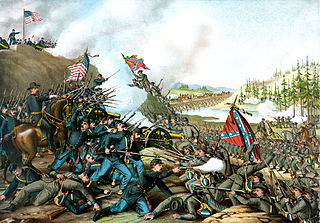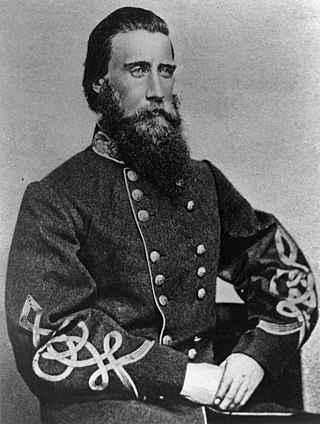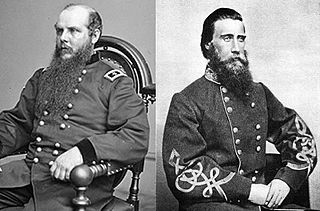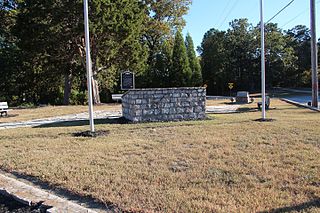
The Battle of Atlanta took place during the Atlanta Campaign of the American Civil War on July 22, 1864, just southeast of Atlanta, Georgia. Continuing their summer campaign to seize the important rail and supply hub of Atlanta, Union forces commanded by William Tecumseh Sherman overwhelmed and defeated Confederate forces defending the city under John Bell Hood. Union Major General James B. McPherson was killed during the battle, the second-highest-ranking Union officer killed in action during the war. Despite the implication of finality in its name, the battle occurred midway through the Atlanta campaign, and the city did not fall until September 2, 1864, after a Union siege and various attempts to seize railroads and supply lines leading to Atlanta. After taking the city, Sherman's troops headed south-southeastward toward Milledgeville, the state capital, and on to Savannah with the March to the Sea.

The Battle of Franklin was fought on November 30, 1864, in Franklin, Tennessee, as part of the Franklin–Nashville Campaign of the American Civil War. It was one of the worst disasters of the war for the Confederate States Army. Confederate Lieutenant General John Bell Hood's Army of Tennessee conducted numerous frontal assaults against fortified positions occupied by the Union forces under Major General John Schofield and was unable to prevent Schofield from executing a planned, orderly withdrawal to Nashville.

John Bell Hood was a Confederate general during the American Civil War. Hood's impetuosity led to high losses among his troops as he moved up in rank. Bruce Catton wrote that "the decision to replace Johnston with Hood was probably the single largest mistake that either government made during the war." Hood's education at the United States Military Academy led to a career as a junior officer in the infantry and cavalry of the antebellum U.S. Army in California and Texas. At the start of the Civil War, he offered his services to his adopted state of Texas. He achieved his reputation for aggressive leadership as a brigade commander in the army of Robert E. Lee during the Seven Days Battles in 1862, after which he was promoted to division command. He led a division under James Longstreet in the campaigns of 1862–63. At the Battle of Gettysburg, he was severely wounded, rendering his left arm mostly useless for the rest of his life. Transferred with many of Longstreet's troops to the Western Theater, Hood led a massive assault into a gap in the Union line at the Battle of Chickamauga but was wounded again, requiring the amputation of his right leg.

The Army of Tennessee was the principal Confederate army operating between the Appalachian Mountains and the Mississippi River during the American Civil War. Named for the State of Tennessee, It was formed in the same state in late 1862 and fought until the end of the war in 1865, participating in most of the significant battles in the Western Theater.

The Army of the Tennessee was a Union army in the Western Theater of the American Civil War, named for the Tennessee River. A 2005 study of the army states that it "was present at most of the great battles that became turning points of the war—Fort Donelson, Vicksburg, and Atlanta" and "won the decisive battles in the decisive theater of the war."

The Battle of Resaca, from May 13 to 15, 1864, formed part of the Atlanta Campaign during the American Civil War, when a Union force under William Tecumseh Sherman engaged the Confederate Army of Tennessee led by Joseph E. Johnston. The battle was fought in Gordon and Whitfield Counties, Georgia, and is generally viewed as inconclusive.

The Atlanta campaign was a series of battles fought in the Western Theater of the American Civil War throughout northwest Georgia and the area around Atlanta during the summer of 1864. Union Maj. Gen. William Tecumseh Sherman invaded Georgia from the vicinity of Chattanooga, Tennessee, beginning in May 1864, opposed by the Confederate general Joseph E. Johnston.

The Battle of Peachtree Creek was fought in Georgia on July 20, 1864, as part of the Atlanta Campaign in the American Civil War. It was the first major attack by Lt. Gen. John Bell Hood since taking command of the Confederate Army of Tennessee. The attack was against Maj. Gen. William T. Sherman's Union army, which was perched on the doorstep of Atlanta. The main armies in the conflict were the Union Army of the Cumberland, commanded by Maj. Gen. George Henry Thomas and two corps of the Confederate Army of Tennessee.

The Battle of Kennesaw Mountain was fought on June 27, 1864, during the Atlanta Campaign of the American Civil War. The most significant frontal assault launched by Union Major General William T. Sherman against the Confederate Army of Tennessee under General Joseph E. Johnston, it produced a tactical defeat for the Union forces but failed to deliver the result that the Confederacy desperately needed: a halt to Sherman's advance on Atlanta, Georgia.

The Battle of Spring Hill was fought November 29, 1864, at Spring Hill, Tennessee, as part of the Franklin-Nashville Campaign of the American Civil War. The Confederate Army of Tennessee, commanded by Lt. Gen. John Bell Hood, attacked a Union force under Maj. Gen. John M. Schofield as it retreated from Columbia through Spring Hill. Because of a series of command failures, the Confederates were unable to inflict serious damage on the Federals and could not prevent their safe passage north to Franklin during the night. The next day, Hood pursued Schofield and attacked his fortifications in the Battle of Franklin, resulting in severe Confederate casualties.
The Battle of Utoy Creek was fought August 4–7, 1864, during the Atlanta Campaign of the American Civil War. Maj. Gen. William T. Sherman's Union armies had partially encircled the city of Atlanta, Georgia, which was being held by Confederate forces under the command of General John Bell Hood. Sherman had at this point adopted a strategy of attacking the railroad lines into Atlanta, hoping to cut off his enemies' supplies. This was the third direct attack on Confederate positions during the campaign and the effect of success would have ended the siege and won Atlanta on 6 August 1864.

The Battle of Jonesborough was fought between Union Army forces led by William Tecumseh Sherman and Confederate forces under William J. Hardee during the Atlanta Campaign in the American Civil War. On the first day, on orders from Army of Tennessee commander John Bell Hood, Hardee's troops attacked the Federals and were repulsed with heavy losses. That evening, Hood ordered Hardee to send half his troops back to Atlanta. On the second day, five Union corps converged on Jonesborough. For the only time during the Atlanta Campaign, a major Federal frontal assault succeeded in breaching the Confederate defenses. The attack took 900 prisoners, but the defenders were able to halt the breakthrough and improvise new defenses. Despite facing overwhelming odds, Hardee's corps escaped undetected to the south that evening.

The Franklin–Nashville campaign, also known as Hood's Tennessee campaign, was a series of battles in the Western Theater, conducted from September 18 to December 27, 1864, in Alabama, Tennessee, and northwestern Georgia during the American Civil War.

The Battle of Dallas was an engagement during the Atlanta Campaign in the American Civil War. The Union army of William Tecumseh Sherman and the Confederate army led by Joseph E. Johnston fought a series of battles between May 25 and June 3 along a front stretching northeast from Dallas toward Acworth, Georgia. At Dallas a probe launched by William B. Bate's and William Hicks Jackson's Confederate divisions accidentally turned into a full-scale assault against the defenses of John A. Logan's XV Corps. The attack was driven off with heavy Confederate losses. The previous Union defeats at New Hope Church and the Pickett's Mill are sometimes considered with Dallas as part of one battle.

The Battle of New Hope Church was a clash between the Union Army under Major General William T. Sherman and the Confederate Army of Tennessee led by General Joseph E. Johnston during the Atlanta Campaign of the American Civil War. Sherman broke loose from his railroad supply line in a large-scale sweep in an attempt to force Johnston's army to retreat from its strong position south of the Etowah River. Sherman hoped that he had outmaneuvered his opponent, but Johnston rapidly shifted his army to the southwest. When the Union XX Corps under Major General Joseph Hooker tried to force its way through the Confederate lines at New Hope Church, its soldiers were stopped with heavy losses.

The Battle of Pickett's Mill was fought in Paulding County, Georgia, between Union forces under Major General William Tecumseh Sherman and Confederate forces led by General Joseph E. Johnston during the Atlanta Campaign in the American Civil War. Sherman sent Brigadier General Thomas J. Wood's division, supported by other formations, to turn Johnston's right flank, but the Federals were repulsed with heavy casualties when they ran into tenacious Confederate opposition. Author Ambrose Bierce, an eyewitness, later wrote an account of the battle titled The Crime at Pickett's Mill.

The 125th Illinois Volunteer Infantry was an infantry regiment from Illinois that served in the Union Army during the American Civil War. Soon after mustering into Federal service in September 1862, the regiment fought at Perryville. After being stationed at Nashville, Tennessee, the unit briefly fought at Chickamauga and served in the Chattanooga and Knoxville campaigns in 1863. The regiment participated in the Atlanta campaign in 1864, where it took heavy losses at Kennesaw Mountain. It also fought at Peachtree Creek and Jonesborough. At the end of 1864, it served during Sherman's March to the Sea and in 1865 the unit fought in the Carolinas campaign. The regiment participated in the Grand Review of the Armies before being mustered out of service in June 1865.

The Battle of Cassville was a clash between the Union Army under Major General William T. Sherman and the Confederate Army of Tennessee led by General Joseph E. Johnston during the Atlanta Campaign of the American Civil War. Johnston attempted to strike a fraction of Sherman's forces with two of his three infantry corps, but the plan miscarried when a Union force appeared from an unexpected direction. Later in the day, Johnston withdrew to a line of field works on a ridge to await attack. However, two of his corps commanders reported that their defenses were enfiladed by Federal artillery fire and that the position could not be held. That night, Johnston decided to withdraw his army south of the Etowah River to a new defense line.
Hiram Bledsoe's Missouri Battery was an artillery battery that served in the Missouri State Guard and the Confederate States Army during the American Civil War. The battery was formed when the Missouri State Guard was formed as a pro-secession state militia unit in response to the Camp Jackson affair. As part of the Missouri State Guard, the unit was engaged in the Engagement near Carthage and the Battle of Wilson's Creek during mid-1861, before fighting at the Battle of Dry Wood Creek and the Siege of Lexington later that year when Major General Sterling Price led the Guard northwards towards the Missouri River. After the Missouri State Guard retreated into Arkansas in early 1862, Bledsoe's Battery served during the Confederate defeat at the Battle of Pea Ridge in March. The battery, as part of the Army of the West, transferred across the Mississippi River into Tennessee in April, where it left the Guard to enter Confederate service on April 21.

The Battle of Gilgal Church was an action during the Atlanta Campaign in the American Civil War. The Union army of William Tecumseh Sherman and the Confederate army led by Joseph E. Johnston fought a series of battles between June 10 and 19 along a front stretching northeast from Lost Mountain to Pine Mountain to Brushy Mountain. At Gilgal Church, attacks by the divisions of John W. Geary and Daniel Butterfield from Joseph Hooker's XX Corps were repulsed with about 700 casualties by Confederates from William J. Hardee's corps. That day in a separate action, other Union troops overran a Confederate skirmish line, capturing about 300 men. Gilgal Church was part of a series of minor actions that included the Battle of Latimer's Farm on June 17–18.






























